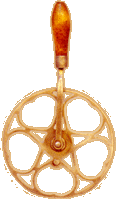 This
tool, with an 8" diameter wheel was used to roll around the outside of a wooden wagon
wheel to determine the circumference in order to make the iron tire to the right size.
Early travelers were hand forged; later Victorian travelers incorporated decorative
geometric patterns. Later (17th & 18th Century) versions were cast iron and and had
pointers attached to the central pivot to help keep count of the number of revolutions.
Modern surveyors routinely use travelers equipped with a mechanical counter and a long
handle. The tool is walked along the ground to measure distance. Get a closer view of the object (50KB) This
tool, with an 8" diameter wheel was used to roll around the outside of a wooden wagon
wheel to determine the circumference in order to make the iron tire to the right size.
Early travelers were hand forged; later Victorian travelers incorporated decorative
geometric patterns. Later (17th & 18th Century) versions were cast iron and and had
pointers attached to the central pivot to help keep count of the number of revolutions.
Modern surveyors routinely use travelers equipped with a mechanical counter and a long
handle. The tool is walked along the ground to measure distance. Get a closer view of the object (50KB)
"...the smith would hold [the traveler] out, waist - high, at
right angles to himself, and run round wheel and tyre in turn. Wheel first, he wheel was
laid up, face - downwards, where Will could walk around it, gravely chalking the
"traveler" where it came round again to the starting point. This was probably
done twice over, to make sure. Meanwhile the helpers looked on silently, too fascinated by
the interest of the job to joke, though we liked joking. There were one or two questions I
might have asked, had Will been less deaf. As it was I never quite knew how the
circulation’s of the traveler were counted, if at all. Having gone all around the
outer circumference of the felloes [wooden rim of the wheel], Will accordingly, lifting
his leather apron, straddled over, long-legged, to the inner side of the tyre, and
solemnly ran the traveler round that also, usually twice as before. "
Excerpt from "The Wheelwright’s Shop" by George Sturt
Cambridge University Press first published 1923.
Suggested further reading:
|
![]()
 This
tool, with an 8" diameter wheel was used to roll around the outside of a wooden wagon
wheel to determine the circumference in order to make the iron tire to the right size.
Early travelers were hand forged; later Victorian travelers incorporated decorative
geometric patterns. Later (17th & 18th Century) versions were cast iron and and had
pointers attached to the central pivot to help keep count of the number of revolutions.
Modern surveyors routinely use travelers equipped with a mechanical counter and a long
handle. The tool is walked along the ground to measure distance. Get a closer view of the object (50KB)
This
tool, with an 8" diameter wheel was used to roll around the outside of a wooden wagon
wheel to determine the circumference in order to make the iron tire to the right size.
Early travelers were hand forged; later Victorian travelers incorporated decorative
geometric patterns. Later (17th & 18th Century) versions were cast iron and and had
pointers attached to the central pivot to help keep count of the number of revolutions.
Modern surveyors routinely use travelers equipped with a mechanical counter and a long
handle. The tool is walked along the ground to measure distance. Get a closer view of the object (50KB)